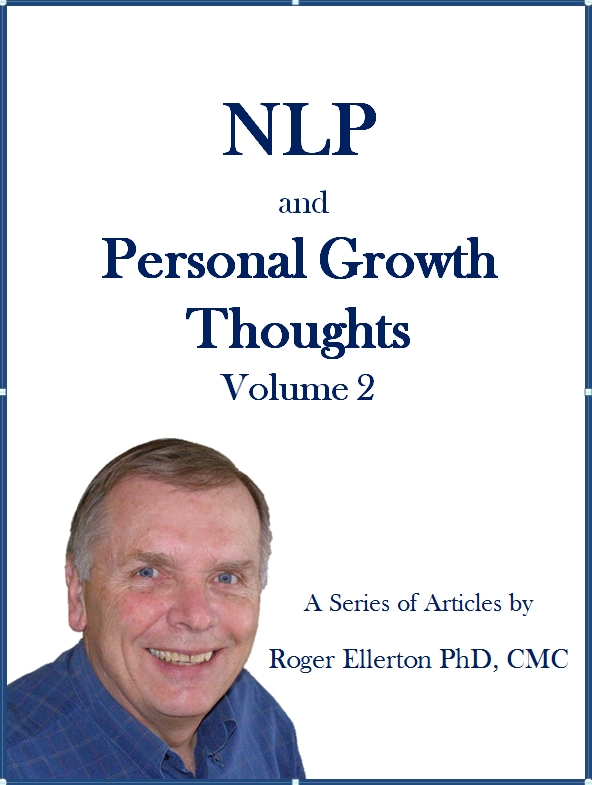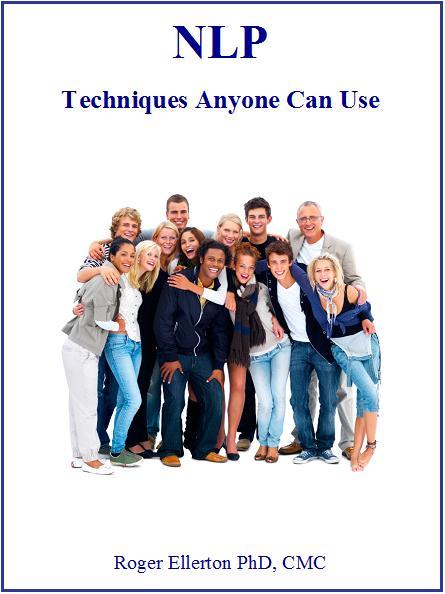NLP Meta Programs, Part I
By Roger Ellerton Phd, ISP, CMC, Renewal Technologies Inc.
This article may not be republished without written permission from Roger Ellerton/Renewal Technologies Inc. If you republish this article without permission, you will be in violation of copyright law and sent an invoice. You may share this and other pages with your friends by linking directly to this page from your website or blog.
Meta Programs are filters that determine how you perceive the world around you and have a major influence on how you communicate with others and the behaviours you manifest. For more information on filters, see the article NLP Communication Model, Part I.
Meta means over, beyond, above, or on a different level - i.e. operating at an unconscious level. Meta Programs are deep-rooted mental programs, which automatically filter our experience and guide and direct our thought processes, resulting in significant differences in behaviour from person to person. They define typical patterns in the strategies or thinking styles of an individual, group, company or culture.
Leslie Cameron-Bandler originally identified about 60 different patterns. Fortunately, subsequent researchers have combined many of these together to form a much smaller and more useful set. The number and descriptions of the patterns vary slightly from author to author. In this article, we have chosen to work with the Meta Programs as described by Rodger Bailey, who adapted them for use in business settings - marketing, selling, team building, organizational change, presentations, negotiation, hiring staff, selecting your ideal job, ... . And the Meta Programs, as described by Rodger, are equally effective in non-business situations as well - with your spouse, your children, buying a car, or any time and place that it is important for you to effectively communicate your thoughts or to gain an increased understanding as to why you behave in a certain way. Rodger determined that people who have the same language profile generally have the same behaviour patterns. Hence, based on the words a person uses, we can make predictions about his/her behaviour. Also once we determine a person's behaviour patterns, we can choose specific words that will have the most influence on that person (influencing language). Rodger refers to this as the LAB Profile or the Language and Behavior Profile.
Roger Bailey describes two types of Meta Programs - Motivation Traits and Working Traits. This article will focus on Motivation Traits. Working Traits are discussed in the article Meta Programs, Part II. For a comprehensive discussion of Meta Programs as developed by Rodger Bailey, see the book by Shelle Rose Charvet titled Words that Change Minds: The 14 Patterns for Mastering the Language of Influence.
Some Points to Consider:
- Exhibiting a particular set of Meta Programs in a specific context does not imply that you have the same pattern in all contexts (e.g. at work or at home). Also your metaprograms may change over time as you learn new information (becoming aware of Meta Programs through this article may influence how you perceive and react to the world) or experience significant events in your life.
- As you read the description of a Meta Program, if you have difficulty believing someone can live their life this way or if you can't stand someone who lives their life this way, then you are probably at the other end of the spectrum. On the other hand, if you really relate to one of the descriptions, then, this is mostly likely true for you. And of course, you could be in the middle, between the two extremes.
- Being at one end of the spectrum or in the middle is not better than the others. Each has its positive and negative aspects. It is important to realize that where you are positioned on the continuum is how you live your life and that other people may see the world quite differently. If you wish to have a meaningful conversation or relationship with other people who have different metaprograms; you need to respect their model of the world, be flexible and speak to them in their language.
- You can identify a person's Meta Programs from the language they use and/or their behaviours. If they exhibit characteristics from both extremes, then they are in the middle.
- We tend to hire people who are like us (similar Meta Programs) and form teams of "like" people. Often teams and business units function best if you have people with different viewpoints, motivation and work traits (Meta Programs).
Motivation Traits
1. Toward - Away From
Is the person's motivational energy centered on goals/achievements or on problems to be dealt with or issues to be avoided?
Toward: These people are focused on their goals. They are motivated to have, get, achieve, attain, ... . They tend to be good at managing priorities and sometimes have trouble recognizing what should be avoided or identifying problems. They are clear in terms of what they want. To motivate/influence these people, use words such as: accomplish, attain, obtain, get, achieve, rewards, goals, ... . To identify this type of person, notice if they use the preceding words and if they speak about achieving goals and outcomes. An ideal type of job for this person would be one that is goal oriented. These people would make poor proofreaders, as they would not be looking for the mistakes.
Away From: People in this group notice what should be avoided, gotten rid of or fixed. They are motivated when there is a problem to be solved or when something needs fixing or is to be avoided. They are good at trouble shooting, solving problems and pinpointing possible obstacles because they automatically pick up what is wrong. They may set goals, however they are easily distracted to respond to negative situations and will drop everything to fix something. They have difficulty managing priorities. You can motivate or identify this type of person by the following words: avoid, steer clear of, prevent, eliminate, solve, fix, get rid of, prohibit, ... . An ideal position would be one that involves identifying problems - e.g. proofreader, quality assurance. Their management style is crisis management.
Distribution (in a work context): Toward (40%), Toward and Away From (20%), Away From (40%)
2. Internal - External
Does the person assess their performance through their own internal standards/beliefs or through information/feedback from external sources?
Internal: These people have their own internal standards and make their own judgments about the quality of their work. They have difficulty accepting other people's opinions and outside direction, even if they are good ideas. If they receive negative feedback on something they believe they have done well, they will question the judgment of the person giving the feedback. As a result, they may be difficult to supervise. They may gather information from outside sources; however they will assess it based on their own internal standards. Since they do not need feedback on how well they are doing, as managers they tend not to give feedback to others. You can motivate this type of person by the following words: you know what's best, only you can decide, it is up to you, I need your opinion, ... . Their ideal job is one in which they can make their own decisions.
External: People in this group need to be managed and receive outside direction and feedback to stay motivated and to know how well they are doing. Without external validation, they may feel lost or have difficulty starting or continuing an activity. They may interpret a simple discussion as an order and then feel swamped with all you have directed them to do. They are motivated by words such as: according to the experts, others will think highly of you, you will be recognized for your efforts, ... . These people make good customer service representatives.
To identify if a person is Internal or External, ask them a question such as: "How do you know you have done a good job?"
Distribution (in a work context): Internal (40%), Internal and External (20%), External (40%)
3. Options - Procedures
Does the person look for alternatives or like to keep their options open or prefer to follow established procedures?
Options: This group is motivated by the possibility to do something in another way. They are the type of people who will develop procedures and then not follow them. They enjoy breaking or bending the rules. Exploring new ideas and possibilities is of great interest. They may start a new project and not feel compelled to finish it. To motivate/influence these people, use words such as: opportunity, alternatives, break the rules, flexibility, variety, unlimited possibilities, expand your choices, options, ... . Use of words such as the foregoing, will help you to identify this type of person. These people do well in a situation that requires solutions or alternatives to current systems - e.g. fashion designer, process reengineering.
Procedures: These people like to follow set rules/processes. Once they understand a procedure they will repeat it over and over again. They have great difficulty developing new processes/procedures and without a clearly defined procedure feel lost or stuck. They are more concerned about how to do something than why they should do it. Bending or breaking rules is heresy! They are motivated by words such as: correct way, tried and true, first ... then ... lastly, proven path, follow this procedure to the letter, ... . Positions suited to these people would be bookkeeper or commercial airline pilot.
Distribution (in a work context): Options (40%), Options and Procedures (20%), Procedures (40%)
In the article, NLP Meta Programs, Part II, we discuss the remaining Motivation Traits and three Working Traits.
And NLP is Much more than that!
Author: Roger Ellerton is a certified NLP trainer, certified management consultant and the founder and managing partner of Renewal Technologies. The above article is based on his book Live Your Dreams Let Reality Catch Up: NLP and Common Sense for Coaches, Managers and You.
Copyright © 2004, Renewal Technologies Inc. All rights reserved.








